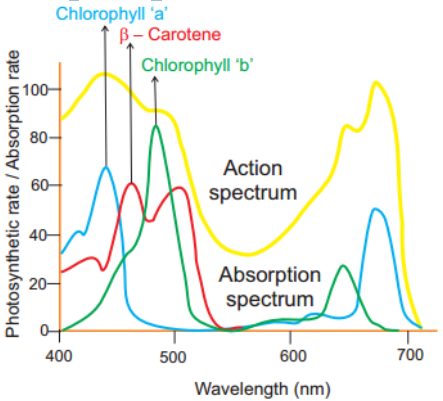1. Absorption spectrum: The term absorption refers to complete retention of light, without reflection or transmission. Pigments absorb different Wavelengths of light. A curve obtained by plotting the amount of absorption of different wavelengths of light by a pigment is called its absorption spectrum.
- Chlorophyll ‘a’ and chlorophyll ‘b’ absorb quanta from blue and red region.
- Maximum absorption peak for different forms of chlorophyll ‘a’ is 670 to 673, 680 to 683 and 695 to 705 nm.
- Chlorophyll ‘a’ 680 (P680) and Chlorophyll ‘a’ 700 (P700) function as trap centre for PS II and PS I respectively.
2. Action Spectrum: The effectiveness of different wavelength of light on photosynthesis is measured by plotting against quantum yield. The curve showing the rate of photosynthesis at different wavelengths of light is called action spectrum. From the graph showing action spectrum, it can be concluded that maximum photosynthesis takes place in blue and red region of the spectrum. This wavelength of the spectrum is the absorption maxima for Chlorophyll
(a) and Chlorophyll
(b). The Action Spectrum is instrumental in the discovery of the existence of two photosystems in O2 evolving photosynthesis.
